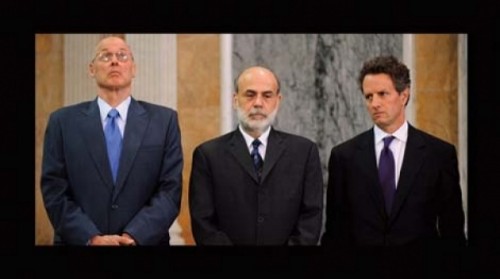Inside Job, Cool It
How much are current documentaries telling us what we want to hear?
By Scott Renshaw @scottrenshawSo what do we expect from nonfiction filmmaking in the 21st century, where the genre has been dominated in recent years by films with a particular political or social ax to grind? And how can we honestly evaluate their merits when so much of our reaction comes from the extent to which we’re predisposed to believe what they have to say?
Inside Job, from director Charles Ferguson (No End in Sight) takes on a subject about which he can be plenty “documentary,” in the sense of providing documentation. As narrated by Matt Damon, the film explores the world financial collapse of 2008—and it’s an ugly picture of unregulated financial institutions run amok, and all the supporting players who also were making too damned much money to worry about what might happen if an economic bubble were based on brokerages selling worthless mortgages as though they were gold, even as they were betting that those mortgages would fail.
Ferguson is hardly the first person to try to provide a layperson’s perspective on this complex mess, either in film (following Michael Moore’s Capitalism: A Love Story) or in print—but he does one of the most efficient jobs at summarizing the key points. From the securities-ratings agencies who gave a thumbs-up to shaky derivatives to the academic economists who are making plenty of side cash by propping up whatever the highest bidder wants to hear to the government officials merely making temporary stops between stints at Goldman Sachs, there’s plenty of well-deserved—and well-documented—blame to go around.
But while it’s undeniably informative and solidly constructed, it’s also the work of a filmmaker who doesn’t even bother disguising the incredulity in his voice when his interview subjects provide ridiculous answers, or get flustered or angry when challenged. Here, Ferguson plays our surrogate, the guy shaking the cages of the jagoffs who got away with millions while leaving the rest of country shellshocked. And as cathartic as those moments may be, they make it harder to focus on how little his words are needed when the perpetrators are more than capable of hanging themselves with their own.
Yet Ferguson is still more effective in his cinematic journalism than Ondi Timoner is in Cool It. Taking a break from her fly-on-the-wall documentaries like Dig! and We Live in Public, Timoner introduces us to Bjorn Lomborg, a Danish researcher who became a focus of controversy after his book The Skeptical Environmentalist made the case that even if manmade global climate change were real, the conventional-wisdom proposals for addressing it were far too expensive for the benefits that would be realized.
The boyish, exuberant Lomborg is a natural as a film subject, and his outside-the-mainstream ideas are certainly intriguing on the surface. But Timoner’s approach bears more than a passing resemblance to Davis Guggenheim’s An Inconvenient Truth, and not just because we spend a fair amount of time watching Lomborg give a PowerPoint presentation. Cool It turns out to be fairly straightforward hagiography, an opportunity to let Lomborg lay out his ideas unchallenged for 90 minutes—which might have been acceptable if Timoner hadn’t spent the early part of the film making it clear how many of his peers seem to think he doesn’t know what he’s talking about. We even get scientist Stephen Schneider, who initially is shown berating Lomborg, serving up quotes that seem to back up many of Lomborg’s points. Whatever the challenges may be to Lomborg’s methodologies or conclusions, we get no sense of what they are here.
But that’s the frustrating reality of contemporary nonfiction filmmaking: You’re getting a lot of talented film artists telling what clearly might be only the part of the story they want to tell, or the part they think we want to hear.
INSIDE JOB
Documentary
Rated PG-13
COOL IT
Documentary
Not Rated
|
Scott Renshaw
|
More by Scott Renshaw
-
Film Reviews: New Releases for April 12
Civil War, Escape from Germany, Coup de Chance, Hundreds of Beavers, La Chimera, Sting
- Apr 11, 2024
-
University of Utah School of Music premiere of A.L.I.C.E.
Composer connects the Lewis Carroll story to her experience living with autism
- Apr 10, 2024
-
Beavers and Spiders and Thieves, Oh My
Three new films cover a wide range of styles.
- Apr 10, 2024
- More »
Latest in Film Reviews
Readers also liked…
-
Power Plays
Two satirical comedies explore manipulations and self-delusions by those with power.
- Aug 31, 2022







